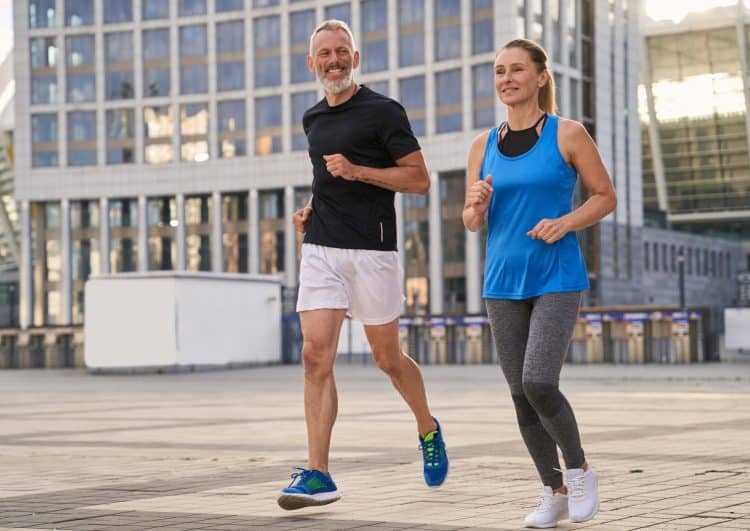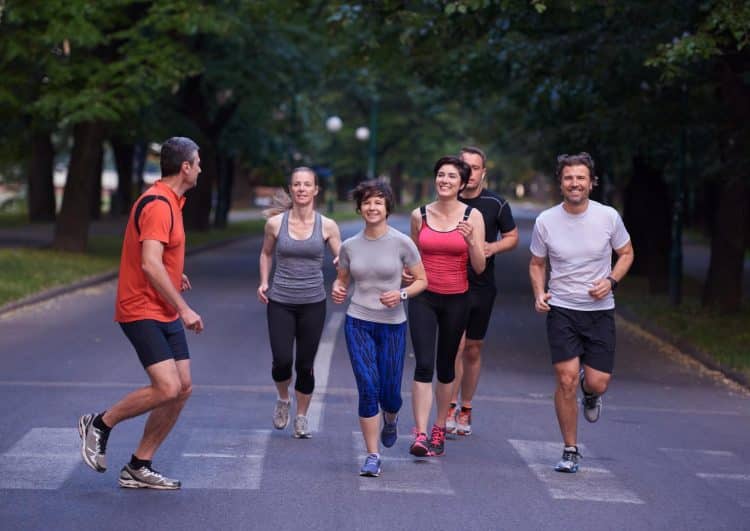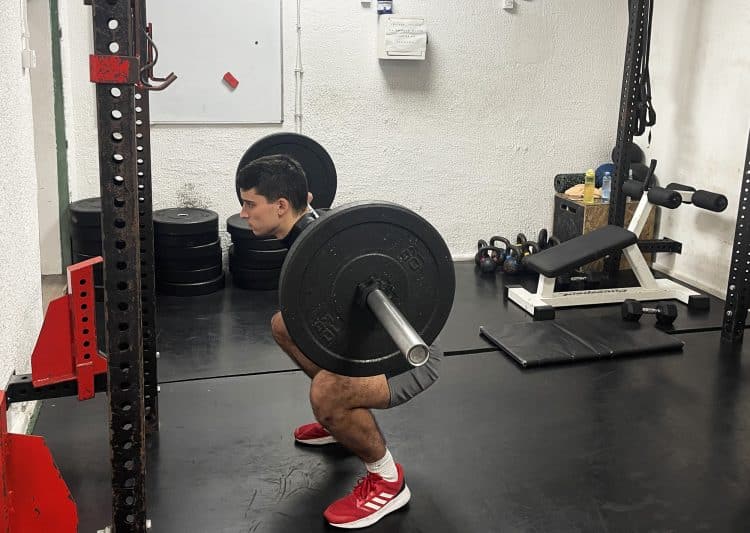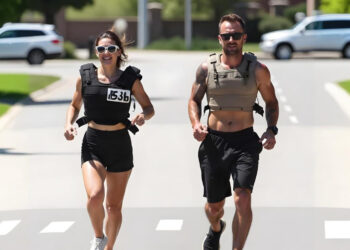Walking is a fundamental (but underrated) form of exercise.
As a 16-year gym veteran and a personal trainer, I’m often approached for advice on weight loss. ‘Walk more’ is my most common recommendation, as I’ve witnessed firsthand the transformative power of this simple, accessible activity.
A 12-week randomized control trial published in The Journal of Nutrition found that the group that added walking to their diet showed a more significant decrease in body weight and fat mass than the diet-only group. The research highlighted that moderate walking enhanced the effects of a diet on fat loss and serum insulin. (1)
However, how you can optimize your walks for maximal calorie burning and weight loss results is a million-dollar question.
Enter, walking pace.
Learning about the average walking pace can help boost your health and achieve your goals faster. It can also be a benchmark for tracking progress and setting realistic fitness goals.
Level Up Your Fitness: Join our 💪 strong community in Fitness Volt Newsletter. Get daily inspiration, expert-backed workouts, nutrition tips, the latest in strength sports, and the support you need to reach your goals. Subscribe for free!
In this article, you will not only learn about the importance of walking but walking at a pace that challenges your cardiovascular system. You will also learn about the factors that affect your walking pace, including age, gender, fitness level, terrain, and tips to boost your average walking pace.
Average Walking Speed vs. Average Walking Pace
Many people use walking pace and walking speed interchangeably. However, these are two different concepts. Here is a brief overview:
- Average Walking Speed: It is measured in units of distance per unit of time (mph and kph) and tells you how fast a person moves. An adult’s average walking speed is around 3 to 4 mph (4.8 to 6.4 kph).
- Average Walking Pace: Pace is often expressed in terms of time per unit of distance, such as minutes per mile or minutes per kilometer — the opposite of walking speed. A typical walking pace might be 15 to 20 minutes per mile (9 to 12 minutes per kilometer).
To sum it up, speed is how fast you’re moving, while pace is how long it takes to cover a set distance.
According to the Centers for Disease Control and Prevention (CDC), the average walking pace for most individuals is approximately 15 to 20 minutes per mile. This pace translates to 3 to 4 miles per hour. (2)
Age and Gender Dynamics in Average Walking Pace
In my extensive experience as a personal trainer and fitness writer, I’ve observed how age and gender significantly influence walking pace due to physiological and anatomical variations.
Age plays a critical role in determining the average walking pace. Young adults typically walk faster due to greater muscle mass, higher aerobic capacity, and more robust joint health. These factors witness a gradual decline with age, leading to a slower pace.
Gender can also affect walking speeds. Men generally tend to walk faster than women, a phenomenon that can be attributed to differences in leg length and muscle distribution. That said, this can vary vastly depending on each individual.
Here is a brief overview of the average walking pace according to age and gender:
| Age | Walking Pace min/mile |
| <30 | 20:00 |
| 30–39 | 21:24 |
| 40–49 | 21:24 |
| 50–59 | 21:40 |
| >60 | 22:13 |
| >65 | 33:30 |
A study published in BMJ found that a brisk walking pace was associated with lower mortality risk from these causes compared to a slow walking pace. (3)
The Impact of Fitness Level on Average Walking Pace
An individual’s fitness level significantly influences their cardiovascular health, muscular strength, and overall stamina. Here are the average walking pace for people of different fitness levels:
Beginners
Beginners might find a brisk pace for longer walks challenging. Starting at a comfortable pace that aligns with their body’s current abilities is key to maintaining regular walking practice. Beginners generally walk at a pace of 24 to 30 minutes per mile (2 to 2.5 mph). This pace will gradually improve as their endurance and cardiovascular health improve.
Beginners aiming to boost their average walking pace should focus on consistency. Regular walks, combined with a balanced diet and recovery program, can significantly enhance your average walking pace. Incorporating fitness activities like CrossFit, swimming, and biking can also improve your walking pace.
I recommend my personal training clients set incremental goals, including slight increases in pace and distance each week, to boost their performance.
Intermediate
To be an intermediate-level walker, an individual must be consistent with their walking practice for at least a couple of months. People at this level can maintain a pace of 17 to 24 minutes per mile (2.5 to 3.5 mph), owing to improved endurance and muscle strength.
Advanced
Advanced-level walkers can maintain a 17 minutes per mile (3.5 mph) pace for extended lengths. Walking regularly at a fast pace boosts your cardiovascular endurance, which can lead to better performance in other demanding sports.
Average Walking Pace for Different Purposes
It’s important to note that the purpose behind walking influences the pace one maintains. For example, walking for improving your fitness will generally involve walking at a fast pace compared to walking for commuting, which involves a leisurely pace.
Walking for fitness involves walking briskly to elevate heart rate and boost cardiovascular health. This generally involves maintaining a pace of 3 to 4 mph.
Leisurely walking, on the other hand, is more relaxed. While hitting the pace, distance, or heart rate objective is generally the goal during a brisk walk, a leisurely stroll is usually about enjoying the surroundings, relaxing, and mindfulness. A leisurely pace is generally around 2 to 2.5 mph.
As a rule of thumb, you should be able to maintain an easy conversation during a leisurely walk, whereas maintaining an extended chat shouldn’t be easy during a brisk walk.
Commuting by foot involves maintaining a balance between efficiency and comfort, which usually works out to 2.5 to 3 mph. Walking too slow can lead to running late for important events, whereas walking too fast can result in physical strain.
Pro Tip: Wearing a fitness tracker (smartwatch or pedometer) during workouts can help track your walking pace in real time. It allows you to adjust your speed to ensure you hit your calorie and distance goals.
Level Up Your Fitness: Join our 💪 strong community in Fitness Volt Newsletter. Get daily inspiration, expert-backed workouts, nutrition tips, the latest in strength sports, and the support you need to reach your goals. Subscribe for free!
Once an individual learns about the average walking pace, the next question is usually about the ideal exercise time.
A clinical trial published in the International Journal of Obesity examined the effects of two different volumes of walking exercise prescriptions, combined with a low-fat diet, on weight loss. The 12-week intervention found that both lower and higher-volume walking regimens resulted in similar and significant beneficial changes in several health-related variables. (4)
The study added that 30 minutes of walking most days a week can be as beneficial as 60 minutes for promoting health benefits over diet alone.
Check out our calories burned walking calculator.
Role of Terrain and Environment in Average Walking Pace
Different terrains — flat, uphill, and rugged trails — pose unique challenges and necessitate adjustments in walking pace.
Maintaining a steady, quick pace is the easiest on a flat terrain, as it allows for consistency in stride and minimal resistance. On a flat surface, individuals can walk at around 3 to 4 mph, depending on their fitness level.
Uphill walking involves more muscular effort, especially in the lower body. The incline slows down one’s pace and increases the cardiovascular strain. An uphill walk usually involves 2 to 2.5 mph. People who don’t have access to a trek can use the incline feature on a treadmill at the appropriate walking speed.
Rugged trails, in my experience, present the biggest challenge. They require careful navigation, which inevitably slows down the pace. A 1.5 to 2 mph pace on rugged terrain is the most realistic.
Switching up your walking terrain can introduce new challenges to your workouts, which can be incredibly effective for improving your endurance, cardiovascular health, and overall fitness levels.
However, you must adjust your walking pace according to each terrain for efficiency and safety. Going too fast on a rugged terrain can increase injury risk, whereas going too slow on a flat surface can result in suboptimal cardiovascular workout performance.
Advanced Techniques to Increase Average Walking Pace
Here are some of the most effective methods of boosting walking speed:
Interval Training
Interval training is an effective method that involves alternating between fast-paced and moderate walking. This technique boosts cardiovascular endurance and leg strength, which is crucial for a quicker pace.
Interval training involves walking briskly for a set time, for example, two minutes, and then slowing down for a minute. These types of workouts include repeating this cycle throughout the walk.
Strength Training
Strength training, especially for the lower body, can help improve the average walking pace. Exercises like squats, lunges, and calf raises build the muscle groups used in walking. Strengthening these muscles supports faster and more efficient walking.
Flexibility and Mobility Work
Flexibility and mobility are often overlooked while training to improve walking pace. Increasing flexibility and joint mobility, particularly in the hips and ankles, has helped improve my gait and walking pace.
Incorporating regular stretching into your routine, including hip flexor stretches and ankle circles, can ensure a more extended range of motion, allowing for longer strides and a faster average walking pace.
Technique Optimization
Stride length, arm swing, and posture can significantly impact speed. For example, maintaining a straight torso with a slight forward lean and swinging arms in coordination with the opposite leg helps propel the body forward more efficiently.
Working with a running coach can help improve your gait and technique, which can enhance your walking pace. Hiring a professional might cost you some money upfront, but the results will pay dividends in the long term.
Speed Drills
Incorporating speed drills, such as high knees and butt kicks, can boost your walking pace and lower body explosive strength. These drills improve leg turnover rate, an essential aspect of walking faster.
Tools and Apps to Measure and Track Walking Pace
Here are some tools to improve your average walking pace:
Smartphone Apps
Apps like Strava, MapMyWalk, Nike Run Club, Apple Workout, and Google Fit are excellent for tracking workouts. These apps give you reliable data about your training activity, which can boost your overall performance.
Fitness Trackers and Smartwatches
Wearable devices like smartwatches and heart rate sensors can deliver even more accurate results as they are in direct contact with your skin, monitor heart rate and calories burned, and even provide detailed insights like stride length. This data allows you to adjust your walking speed on the fly.
How To Use These Tools Effectively
Start small and use the tracking tools with the least friction. Begin by tracking the duration and distance of your daily walks. Monitor your average pace and set small, incremental goals for improvement. Share your goals and progress with a professional for a personalized training program for better results.
Conclusion
The average walking pace of an adult is usually between 15 and 20 minutes per mile (3 to 4 mph) and can change depending on the terrain, environment, and objective. Walking at a brisk pace is an incredibly effective method for people of all fitness levels to improve their endurance and overall health and well-being.
If you have any questions about the average walking pace, drop them in the comments below, and I’ll be happy to help!
References
- Kleist B, Wahrburg U, Stehle P, Schomaker R, Greiwing A, Stoffel-Wagner B, Egert S. Moderate Walking Enhances the Effects of an Energy-Restricted Diet on Fat Mass Loss and Serum Insulin in Overweight and Obese Adults in a 12-Week Randomized Controlled Trial. J Nutr. 2017 Oct 1;147(10):1875-1884. doi: 10.3945/jn.117.251744. PMID: 28794207.
- U.S. Department of Health and Human Services. Physical Activity Guidelines for Americans, 2nd edition. U.S. Department of Health and Human Services; 2018. Available from: https://health.gov/sites/default/files/2019-09/Physical_Activity_Guidelines_2nd_edition.pdf
- Stamatakis E, Kelly P, Strain T, Murtagh EM, Ding D, Murphy MH. Self-rated walking pace and all-cause, cardiovascular disease, and cancer mortality: individual participant pooled analysis of 50 225 walkers from 11 population British cohorts. Br J Sports Med. 2018 Jun;52(12):761-768. doi: 10.1136/bjsports-2017-098677. PMID: 29858463.
- Bond Brill J, Perry AC, Parker L, Robinson A, Burnett K. Dose-response effect of walking exercise on weight loss. How much is enough? Int J Obes Relat Metab Disord. 2002 Nov;26(11):1484-93. doi: 10.1038/sj.ijo.0802133. PMID: 12439651.













